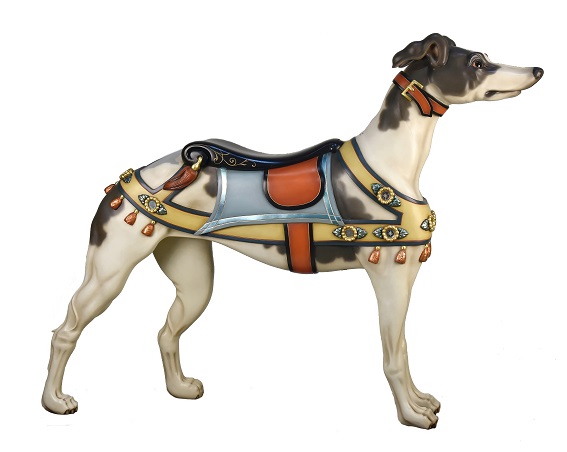By Crocker Staff
The Crocker Art Museum may be temporarily closed to the public due to COVID-19, but Museum staff have rolled out the red carpet in welcome for a menagerie of carousel animal sculptures including a deer, giraffe, horse, goat, bear, and greyhound!
The six sculptures were hand-carved by top makers from the golden age of carousels, and are a generous gift to the Crocker from the renowned collection of the Freels Foundation.
The golden age of carousels spanned the 1880s through the 1920s, when resorts and cities throughout the United States and England featured them in their amusement parks. Most carousel animals were horses and were based on the French 17th-century origins of the ride. Additional menagerie animals were later added, including lions, tigers, giraffes, deer, rabbits, goats, pigs, ostriches, bears, and dogs.
Objects in order of appearance: Gustav Dentzel (American, born Germany, 1844–1909), Bear, ca. 1907. Basswood and pigments, 50 x 60 x 11 in. Crocker Art Museum, gift of Larry and Gail Freels, 2019.94.5.
Gustav Dentzel (American, born Germany, 1844–1909), Giraffe, ca. 1907. Basswood and pigments, 49 x 71 x 12 in. Crocker Art Museum, gift of Larry and Gail Freels, 2019.94.1.
Gustav Dentzel (American, born Germany, 1844–1909), Goat, ca. 1907. Basswood and pigments, 57 x 60 x 11 in. Crocker Art Museum, gift of Larry and Gail Freels, 2019.94.4.
Gustav Dentzel (American, born Germany, 1844–1909), Horse, ca. 1907. Basswood and pigments and hair, 60 x 62 x 12. Crocker Art Museum, gift of Larry and Gail Freels, 2019.94.6. D.
C. Müller & Bro. Company (active 1903–1914), Standing Deer, ca. 1908. Basswood with pigments, 54 x 69 x 11 in. Crocker Art Museum, gift of Larry and Gail Freels, 2019.94.3.
Charles Looff (American, born Denmark, 1852–1918), Greyhound, ca. 1896. Poplar wood with pigments, 73 x 55 x 11 in. Crocker Art Museum, gift of Larry and Gail Freels, 2019.94.2.
Music: "Merry Go Slower" Kevin MacLeod (incompetech.com)

Charles Looff (American, born Denmark, 1852–1918), Greyhound, ca. 1896. Poplar wood with pigments, 73 x 55 x 11 in. Crocker Art Museum, gift of Larry and Gail Freels, 2019.94.2.
The best carousel carvers were highly trained, their work literally sculpture in motion. Today, carousel sculpture is grouped into three basic carving styles: the Philadelphia Style, the Coney Island Style, and the County Fair Style, the latter being smaller, more simply carved animals intended for traveling fairs.
The Philadelphia Style includes figures by The Dentzel Company and is generally considered the most realistic and graceful. The Dentzel Company created the giraffe, horse, goat, and bear now in the Crocker’s collection. Daniel Müller apprenticed at the Dentzel company prior to founding his own company, D.C. Müller & Bro., in 1902. Müller’s training at the Pennsylvania Academy of Fine Arts is evident in the skillful carving of the deer.
In contrast to the Philadelphia style, the Coney Island style boasted flashier decoration, including silver or gold leaf and sometimes glass jewels. This ornate style is exemplified by Charles Loof’s classic greyhound.
Top Image: Gustav Dentzel (American, born Germany, 1844–1909), Goat, ca. 1907. Basswood and pigments, 57 x 60 x 11 in. Crocker Art Museum, gift of Larry and Gail Freels, 2019.94.4.


